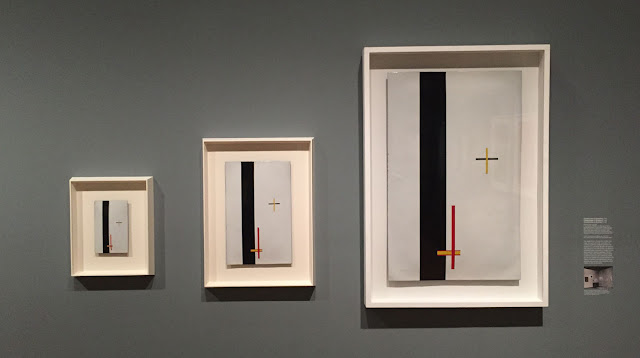Did Moholy-Nagy Phone In These Paintings?
László Moholy-Nagy was a pioneer of multi-media art. He's often credited as a conceptualist too, largely on the strength of the so-called Telephone Paintings of 1922. Three (out of five), each titled Construction in Enamel, are in the retrospective at LACMA, "Moholy-Nagy: Future Present."
As Moholy told it in 1944,
"In 1922 I ordered by telephone from a sign factory five paintings in porcelain enamel. I had the factory's color chart before me and I sketched my paintings on graph paper. At the other end of the telephone, the factory supervisor had the same kind of paper divided in to squares. He took down the dictated shapes in the correct position. (It was like playing chess by correspondence.)"
This was long before Donald Judd and Sol LeWitt's plans for art to be executed by someone else. It's also long before the L.A. brand of not-so-minimal conceptualism. But Moholy's tale has been contested. In a 1972 book the artist's first wife, Lucia, said that László went to the sign factory in person to place the order. He told Lucia, "I even could have done it by telephone."
Early abstractionists have been accused of backdating non-objective works in order to stake a claim for art-historic priority. But Moholy couldn't have wanted to forge conceptualist credentials in the 1940s. Conceptualism wasn't a thing. My guess is that Moholy embellished the truth for the sake of good story. Not in dispute is that Moholy hired a commercial sign painter to create works from his instructions, which he then displayed as "art." That was insane for the time, and it's one reason that Moholy resonates today.
The telephone paintings invite comparison to Pasadena Museum curator Walter Hopps' account of Ed Ruscha's poster for "New Painting of Common Objects." Hopps wrote,
"Edward Rusha designed the poster by calling up a commercial printer who made posters for concerts and boxing matches. Ruscha dictated all the copy over the phone, and his only directions on the type and style were to 'make it loud!'"
The telephone paintings also resonate with the conceptualism of John Baldessari's commissioned paintings (shown, Baldessari's Commissioned Painting: A Painting by Edgar Transue, 1969) and Martin Kippenberger's billboards commissioned from commercial painters.
Somewhere after Kippenberger, digital technology replaced sign painters. The commercial was no longer conceptual. It was just cost-effective. Today artists routinely use digital sign makers to produce work on a big scale. MOCA Grand Avenue is currently sheathed in a commercially produced vinyl reproduction of a Jonas Wood painting, Still Life With Two Owls. Wood did a billboard for New York's High Line, and Henry Taylor is doing another.
Moholy-Nagy's telephone paintings also anticipate the Internet painting mills that will copy any painting, at any size. The Chinese factory Artisoo.com knocks off Moholy-Nagy telephone paintings in seven sizes, more that Moholy-Nagy offered.
As Moholy told it in 1944,
"In 1922 I ordered by telephone from a sign factory five paintings in porcelain enamel. I had the factory's color chart before me and I sketched my paintings on graph paper. At the other end of the telephone, the factory supervisor had the same kind of paper divided in to squares. He took down the dictated shapes in the correct position. (It was like playing chess by correspondence.)"
This was long before Donald Judd and Sol LeWitt's plans for art to be executed by someone else. It's also long before the L.A. brand of not-so-minimal conceptualism. But Moholy's tale has been contested. In a 1972 book the artist's first wife, Lucia, said that László went to the sign factory in person to place the order. He told Lucia, "I even could have done it by telephone."
Early abstractionists have been accused of backdating non-objective works in order to stake a claim for art-historic priority. But Moholy couldn't have wanted to forge conceptualist credentials in the 1940s. Conceptualism wasn't a thing. My guess is that Moholy embellished the truth for the sake of good story. Not in dispute is that Moholy hired a commercial sign painter to create works from his instructions, which he then displayed as "art." That was insane for the time, and it's one reason that Moholy resonates today.
The telephone paintings invite comparison to Pasadena Museum curator Walter Hopps' account of Ed Ruscha's poster for "New Painting of Common Objects." Hopps wrote,
"Edward Rusha designed the poster by calling up a commercial printer who made posters for concerts and boxing matches. Ruscha dictated all the copy over the phone, and his only directions on the type and style were to 'make it loud!'"
The telephone paintings also resonate with the conceptualism of John Baldessari's commissioned paintings (shown, Baldessari's Commissioned Painting: A Painting by Edgar Transue, 1969) and Martin Kippenberger's billboards commissioned from commercial painters.
Somewhere after Kippenberger, digital technology replaced sign painters. The commercial was no longer conceptual. It was just cost-effective. Today artists routinely use digital sign makers to produce work on a big scale. MOCA Grand Avenue is currently sheathed in a commercially produced vinyl reproduction of a Jonas Wood painting, Still Life With Two Owls. Wood did a billboard for New York's High Line, and Henry Taylor is doing another.
Moholy-Nagy's telephone paintings also anticipate the Internet painting mills that will copy any painting, at any size. The Chinese factory Artisoo.com knocks off Moholy-Nagy telephone paintings in seven sizes, more that Moholy-Nagy offered.






Comments
commercial painters Toronto